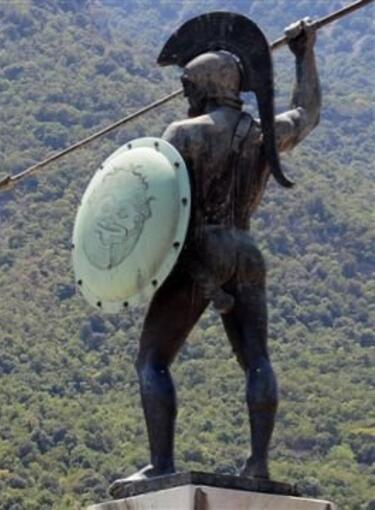 Battles
Battles
Starting / Ending points
Introduction:
The First Median War had just ended. The Persians, after subduing a large part of theAegean Sea and severely punishing Eretria for the help it sent to the rebelliousIonians, suffered a painful defeat at Marathon by the combined forces of theAthenians and Plataeans.The Persian army returned to Asia humiliated, but King Darius the Great, upon hisdeath in 486 BC, bequeathed to his son Xerxes a grudge against the Greeks and apassion for expanding the Persian Empire to the West.Indeed, in the spring of 480 BC, Xerxes and his military force of a legendary sizecrossed the Hellespont and began to move south. The Second Median War had justbegun.The invasion generated controversy among the Greeks. Some wanted to defend theland in the North and others wanted to protect the Peloponnese, and more than a fewwere terrified and sided with the Persians.
1st Stop:
Thermopylae
The first line of defence at the Vale of Tempe was soon abandoned, driving theThessalians into the Persian camp. The first battle would be fought in September480 BC at the strategic location of Thermopylae, where approx. 7,000 hoplites underKing Leonidas of Sparta lined up to cut off the enemy's access to the South.According to the later historian Plutarch, when Xerxes sent heralds asking the Greeksto lay down their arms, Leonidas' response was “Molon Lave”, meaning “Come andtake them”. The Persian King was enraged and ordered the attack.The Greeks, lined up in the straits of Thermopylae, neutralized the numericaladvantage of the Persians, who could not even deploy their cavalry. Thus, the first twodays of the battle ended with significant Persian losses. According to Herodotus, theenemies’ impasse was resolved by Ephialtes, son of Eurydemos, who revealed toXerxes a path that would allow the Persians to emerge behind the Greeks andsurround them.Indeed, during the night, select Persian corps crossed the path, pushed back thePhocians who were guarding it and, thus, the morning found the Greek forcessurrounded. Most of the Greeks fled, but 300 Spartans, 700 Thespians and 400Thebans were left to defend Thermopylae.The conflict was fierce and it was initially fought with spears in an attempt to keep theenemy at bay, but soon swords were drawn and hand-to-hand combat began. Theclimax was the death of Leonidas, followed by a furious battle around the body of thedead King. Herodotus describes how the Greeks who lost their weapons continued tofight using their hands and teeth.The Greek forces were not able to prevail. The Persians massacred those whocontinued to fight and branded with a red-hot iron those who surrendered. Despite thedefeat, the Battle of Thermopylae remains one of the most important moments inworld military history, due to the courage and self-sacrifice of the Greeks. Theepigram of the poet Simonides of Ceos reflects the moral dimension of the conflict:“Go, tell the Spartans, thou who passest by, that here obedient to their laws we lie.”
2nd Stop:
Artemisium
In September 480 BC, at the same time as the Battle of Thermopylae, the Battle ofArtemisium also took place. The Persian fleet, moving south, ran into a raging stormat Cape Sepia, Magnesia, and was greatly weakened. However, it is estimated that,even after this disaster, the Persian force numbered more than 800 ships, whichdocked in the region of Artemisium, in Northern Euboea, a day after the arrival of theground forces at Thermopylae.The Greeks brought fewer than 300 triremes against the Persians. The conflict beganas soon as the Greek ships became visible, although it was already late in the day. TheGreek triremes drew their sterns together in the middle and managed to repel theenemies, who lost 30 ships in this first engagement. In the evening, another stormdestroyed a significant part of the 200 ships sent by the Persians to circle Euboea inorder to prevent the Greeks from escaping.On the second day, the Greeks, having being informed that there was no threat to theirrear, attacked the enemy ships and succeeded in destroying some and capturingothers.On the third day, a fierce naval battle took place as the Persian fleet moved with all itsmight against the Greek fleet, which struggled to hold its ground. Half the Atheniannavy was badly damaged, but, as reported by Herodotus, the Greek triremes managedto inflict equally significant blows on the Persian ships, so the day ended with the twofleets tied.In the evening, the news of the heroic resistance and cruel defeat at Thermopylaereached the Greek ships, which, having suffered serious damage and no longer neededto defend that position, quickly fled to Salamis.
3rd Stop:
Athens
After the defeat of the Greeks at Thermopylae, the whole of Boeotia was at the mercyof the Persians. Cities that resisted the occupation, such as Thespiae and Plataea,experienced the wrath of the conquerors and were plundered.It was Athens’ turn, which had been evacuated at the suggestion of GeneralThemistocles, leader of the Democrats. The Athenians, as well as a large number ofpeople from other regions in Attica, boarded the ships returning from Artemisium andfled to Salamis.In September 480 BC, the Spartan Admiral Eurybiades was setting up a defensive lineat the Isthmus of Corinth and destroying the road from Megara, at the same time whenthe Persians invaded the empty streets of Athens without meeting resistance.The few Athenians who were fortified in Acropolis were quickly defeated and Xerxesgave the order to burn the city. The Old Temple of Athena Polias and theHekatompedon Temple, a precursor to the Parthenon, were razed to the ground. ThePersians transported great works of ancient Greek art to their capital, Susa, such as thesculptural pairing of the tyrannicides, which would be returned to their homelandmany years later by Alexander the Great and his successors.Xerxes had captured the greatest part of the Greek core, but he was several monthsaway from his headquarters with a huge military force, which could not be maintainedfor much longer. His goal was to subjugate all Greeks immediately. The Persianscould not rely on conquest by land, as the Greek forces had resorted to the triremes,outside Salamis. Everything indicated that the war’s outcome would be decided bynaval battle, which would not be long in coming.
4th Stop
Salamis
Xerxes was afraid that the Athenians would slip through his hands again and he wasin a hurry to finish them off. On the other hand, the allies were trapped in the straitsbetween Salamis and Attica. Themistocles perceived that the Great King of thePersians was acting impulsively and he was quick to take advantage of this. TheAthenian General devised a ruse, using messengers to convince the Persians that theAthenians were ready to desert and take refuge in Corinth. Xerxes fell into the trapand ordered his fleet into the straits, turning his numerical superiority into asignificant disadvantage.In late September in 480 BC, between 600 and 800 Persian ships approachedapproximately 300 Athenian triremes at dawn. The Greeks knew the area very well.They knew how to take advantage of the currents and winds, while their ships wererelatively small and nimble. On the other hand, the Persian ships had difficultymanoeuvring, both because of their bulk and their sheer numbers. Pandemonium soonprevailed among the Persians, who started to panic.The opportunity was seized by the Greeks who, well aware of what was at stake,fought with desperate courage under the cries of the war paean composed by thetragedian Aeschylus, who participated in the naval battle: “Come on, sons of theGreeks, for the freedom of your homeland, for the freedom of your children, yourwives, the temples of your fathers’ gods, and the tombs of your ancestors. Now all isat stake.”The first line of Persian ships was violently pushed back by the Athenian triremes,crashing into the second line, which in turn crashed into the third. Herodotus mentionsthat Artemisia, queen of Halicarnassus and subject to Xerxes, in her attempt to escapewith her ship, was forced to attack an allied Persian ship and sink it. The fury of theGreeks was unleashed. They did not hesitate, under the orders of General Aristides, tostrike and destroy even the elite cavalry of the Persians, which had landed on thesmall island of Psyttaleia with the plan to kill any Greek castaways who wereunfortunate to swim there.The Persian fleet tried to retreat, but it was intensely pursued by the Athenian triremesand it fell into an ambush by the Aeginetans. Any Persians who managed to escapetook refuge in the port of Faliro, but their losses were dramatic. It is estimated that, onthat day, the Greeks lost about 20 triremes and the Persians over 200-300 ships.
5th Stop:
Throne of Xerxes – Mount Egaleo
Xerxes, the Great King of the Persians, had settled with his staff on Mount Egaleofrom where he thought he could enjoy his triumph, his victory at Salamis and hisdominion over all Greeks. Moreover, he thought that he would be able to oversee thebattle from his throne and discern which of his officers would distinguish themselvesin battle, so that he could take note of their names and honour them as he saw fit.However, he was soon disappointed.As the Naval Battle began, the first terrible realization both of Xerxes and the otherobservers was that, due to the extreme confusion that prevailed, it became impossibleto distinguish, at the location of the engagement, who was an ally and who was anenemy.The Persians seemed to be fighting in panic, almost blindly. In fact, aware of the factthat their King was on the hill watching them, they tried to distinguish themselvesbefore his eyes through their exploits and they fell into battle with violent passion,which only served to intensify the chaos.Xerxes called a war council and, while he initially proposed to quickly build floatingbridges over the straits of Salamis in order to attack the Greeks, he recognized that theAthenian fleet, now in complete control of the region, would not allow such a thing.The Persian King was overwhelmed by the great fear that the Greeks, in their fury,would destroy the bridges of the Hellespont and trap the Persians in Europe. Asquickly as possible, Xerxes organised the largest part of his army and hurried north, tocross the Hellespont and return defeated to Asia.
6th Stop:
Plataea
After the disastrous defeat at the Battle of Salamis, most of the Persian army followedXerxes when he retreated back to Asia. However, General Mardonius voluntarilystayed behind and, assembling a unit of elite soldiers, chose to retire to Boeotia andsettle down to spend the winter.The winter passed by with negotiations. The Persians attempted to approach Athensand propose an alliance, but this was rejected. Upon consultations, which wereinitiated by the Athenians, the Spartans decided to take action against the Persians andthey enlisted all their Peloponnesian allies.In the summer of 479 BC, Athens, Sparta, Corinth and Megara assembled a powerfularmy of about 70,000 men, led by the Spartan General Pausanias, which forced thePersians to retreat and build a makeshift fort at Plataea.The Greeks did not deploy the army in the area around the fort, where they wouldhave been vulnerable to the Persian cavalry; thus, 12 days went by with minorskirmishes and hesitant movements on both sides. The Persians managed to cut thesupply lines of the Greeks, which disrupted their lines, but did not disorganize themcompletely. However, Mardonius, believing that the Greeks were retreating, orderedan attack.The Greek phalanxes were quickly reorganized. Spartans, Athenians and Tegeansshowed strength and courage, and they managed to repel the Persian cavalry withtheir formation. Soon, the Greeks drove off the enemies and Mardonius himself waskilled during the flight. A large number of Persians were trapped inside the fort,where they were killed.Thanks to the victory at Plataea, the balance of the War shifted. Now, the Greek forceswere looking for what remained of their enemies to eliminate them.The new King ofSparta, Leotychidas, on the same day as the Battle of Plataea, crushed the remnants ofthe Persian fleet at Mykali, while a short time later, the Athenians, led by GeneralXanthippus, campaigned in the Thracian Peninsula, besieging and occupying Sestos.
For Herodotus, the “metis”, i.e. the wisdom, intelligence and industriousness of theGreeks had prevailed over the “hybris”, the unholy arrogance of the Persians, and itnow marked the beginning of a new phase of the Greco-Persian Wars: the GreekCounterattack.



